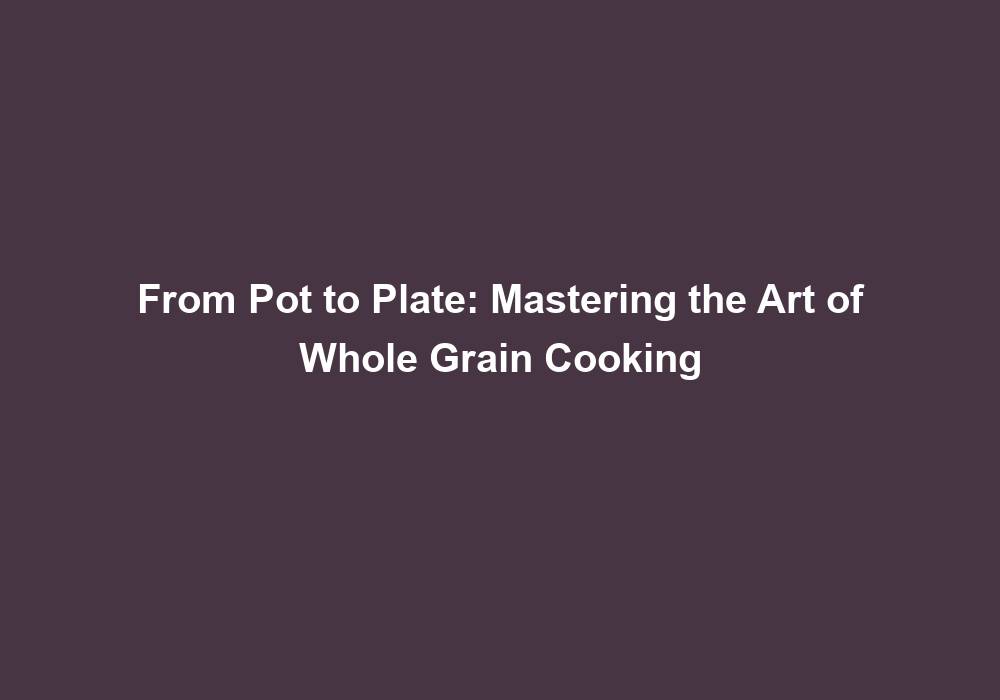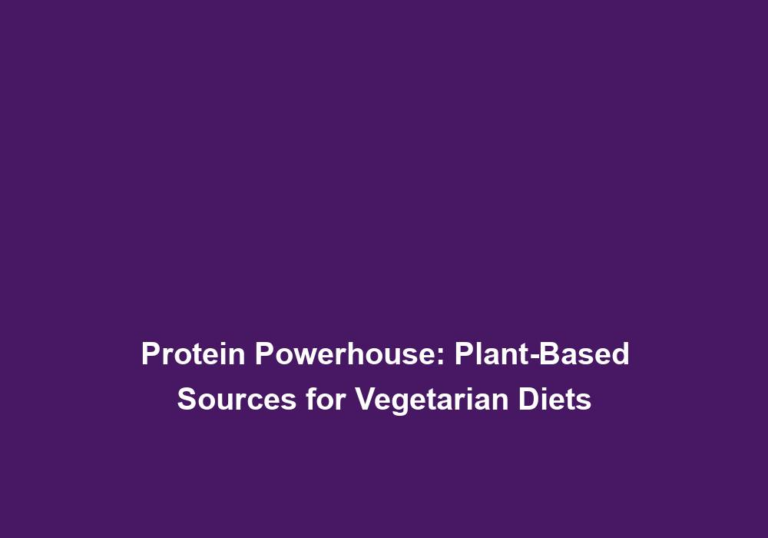From Pot to Plate: Mastering the Art of Whole Grain Cooking
Whole grain cooking is a culinary practice that focuses on using the entirety of grains in their natural state, retaining all the essential nutrients and fiber they offer. By cooking whole grains such as brown rice, quinoa, millet, and oats, you can create flavorful and nutritious meals that will enhance your culinary skills. In this article, we will explore the benefits of whole grains, essential cooking techniques, and provide some inspiring recipes to get you started on your whole grain cooking journey.
Why Whole Grains?
Incorporating whole grains into your cooking repertoire can offer a wide range of benefits for your health. Unlike refined grains that have been stripped of their bran and germ, whole grains contain all three parts – the bran, germ, and endosperm. This means they are packed with fiber, vitamins, minerals, and beneficial plant compounds.
Here are some key benefits of incorporating whole grains into your diet:
-
Nutritional Powerhouses: Whole grains are a great source of dietary fiber, which aids in digestion, helps maintain a healthy weight, and reduces the risk of chronic diseases like heart disease and type 2 diabetes. Additionally, they are rich in essential vitamins and minerals such as B vitamins, iron, and magnesium, which are important for overall health and well-being.
-
Long-Lasting Energy: Whole grains are slower to digest, providing a steady release of energy throughout the day. They can help stabilize blood sugar levels, preventing drastic spikes and crashes that often occur with refined grains. This sustained energy can support your daily activities and keep you feeling satisfied.
-
Weight Management: The high fiber content in whole grains helps you feel full for longer periods, reducing the chances of overeating. This can be particularly beneficial for those trying to maintain a healthy weight or lose excess pounds. Whole grains can be a valuable addition to a balanced diet for weight management.
-
Heart Health: Studies have shown that consuming whole grains regularly can lower the risk of heart disease, stroke, and high blood pressure. The combination of fiber, antioxidants, and phytochemicals found in whole grains work synergistically to promote cardiovascular health. Including whole grains in your meals can contribute to a heart-healthy diet.
Essential Whole Grain Cooking Techniques
To unleash the full potential of whole grains and create delicious meals, it’s essential to understand some fundamental cooking techniques. Here are a few tips to get you started:
1. Cooking Methods:
-
Boiling: Boiling is the most common method used for cooking whole grains. Simply add the grains to a pot of boiling water, reduce the heat, and simmer until tender. The cooking time varies depending on the grain, so be sure to check the package instructions or use a ratio of grain to water as a guideline. Boiling is a versatile cooking method that can be used for a variety of whole grains.
-
Steaming: Steaming is a gentle and effective way to cook grains while preserving their natural flavors and textures. Use a steamer basket or a rice cooker with a steaming function to achieve perfectly cooked, fluffy grains. Steaming is especially suitable for delicate grains like quinoa and millet.
-
Baking: Whole grains can also be cooked in the oven. Baking them in a covered dish or casserole with flavorful liquids like broth or tomato sauce can infuse them with delicious tastes. Baking is a great option for grains like brown rice and wheat berries, as it allows for even cooking and the development of rich flavors.
2. Flavor Enhancements:
-
Toasting: Toasting whole grains before cooking can enhance their nutty flavor and add depth to your dishes. Heat a dry skillet over medium heat, add the grains, and stir continuously until they become fragrant and slightly golden. Be careful not to burn them. Toasting can be done with a variety of grains, such as quinoa, farro, and barley.
-
Seasoning: Experiment with different herbs, spices, and seasonings to add flavor to your whole grain dishes. Fresh herbs like cilantro or thyme, spices like cumin or turmeric, and ingredients like garlic or lemon zest can transform a simple grain into a tasty masterpiece. Seasoning is a creative way to customize the taste of your whole grain dishes according to your preferences.
-
Broths and Stocks: Cooking whole grains in vegetable or chicken broth instead of plain water can infuse them with rich flavors. This technique is especially useful when making pilafs or risottos. The broth or stock adds depth and complexity to the grains, making them more enjoyable and satisfying.
3. Proper Storage:
To keep whole grains fresh and extend their shelf life, store them in airtight containers in a cool, dry place. Some grains, such as oats, can also be kept in the refrigerator or freezer to maintain their quality. Storing whole grains properly ensures that they retain their nutritional value and do not become stale or infested with pests. It’s best to label the containers with the name and date of the grain to keep track of their freshness.
Inspiring Whole Grain Recipes
Now that you have a good understanding of whole grain cooking techniques, let’s explore some exciting recipes to try:
1. Quinoa Salad with Roasted Vegetables
Ingredients:
- 1 cup quinoa
- Assorted vegetables (such as bell peppers, zucchini, and eggplant)
- Olive oil
- Lemon juice
- Fresh herbs (such as parsley or basil)
- Salt and pepper to taste
Instructions:
- Cook quinoa according to package instructions.
- Preheat the oven to 400°F (200°C).
- Toss the vegetables with olive oil, salt, and pepper. Roast in the oven until tender and slightly charred.
- In a large bowl, combine the cooked quinoa, roasted vegetables, lemon juice, fresh herbs, and additional seasonings if desired. Mix well and serve.
2. Brown Rice Pilaf with Mushrooms and Spinach
Ingredients:
- 1 cup brown rice
- Mushrooms (such as cremini or shiitake), sliced
- Onion, diced
- Garlic, minced
- Spinach leaves
- Vegetable broth
- Olive oil
- Salt and pepper to taste
Instructions:
- Cook brown rice according to package instructions.
- In a large skillet, heat olive oil over medium heat. Sauté the onions and garlic until fragrant and golden.
- Add the mushrooms and sauté until they release their moisture and become tender.
- Stir in the cooked brown rice and vegetable broth. Cook for a few minutes until the flavors meld together.
- Add the spinach leaves and cook until wilted. Season with salt and pepper, and serve as a delicious side dish.
3. Overnight Oats with Berries and Almonds
Ingredients:
- 1/2 cup rolled oats
- 1/2 cup milk (dairy or plant-based)
- Greek yogurt
- Fresh berries (such as strawberries, blueberries, or raspberries)
- Almonds, chopped
- Honey or maple syrup (optional)
Instructions:
- In a mason jar or container, combine rolled oats, milk, and a dollop of Greek yogurt. Stir well.
- Add fresh berries and chopped almonds. Mix gently to distribute evenly.
- Cover the jar/container and refrigerate overnight.
- In the morning, give it a good stir, and if desired, drizzle with honey or maple syrup for added sweetness. Enjoy a nutritious and convenient breakfast!
Conclusion
By mastering the art of whole grain cooking, you can elevate your dishes to a new level of nutrition and flavor. Incorporating whole grains into your meals is a fantastic way to improve your overall health and well-being. Remember to experiment with different grains, cooking techniques, and flavor combinations to find your own favorite recipes. So grab your pot and get ready to embark on a journey from pot to plate, savoring the goodness of whole grain cooking along the way!







